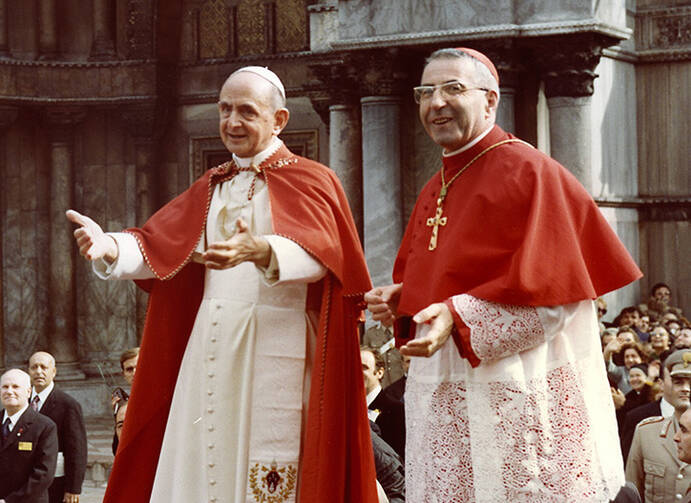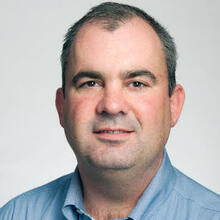Tomorrow around 4:30 p.m. Rome time, when Archbishop Diego Ravelli closes the doors of the Sistine Chapel, the conclave to elect a new pope will begin. For a few hours at least—more likely a day or two—the blitz of media prognostication will come to an end, and in a strangely anachronistic moment, we will all turn our eyes to a little stovepipe atop a building over five centuries old. Sometimes the stovepipe might have a seagull sitting on it.
There’s been some talk about the danger of someone unduly influencing the conclave’s result in the runup, either through politicking or misrepresenting a cardinal’s views. In case you were wondering if this concern was a new one, the second issue ever of America featured an editorial on papal conclaves in which the editors argued (wait for it) that Austria, France and Spain had no right to veto a papal conclave’s selection of a new pope.
This was a thing? Yes: The emperor of Austria had apparently tried just that in the conclave of 1903, exercising his so-called “right of exclusion.” Pope Pius X had denied that there ever was such a right, the editors noted in 1909: “He once more repeats their denunciations of the pretension of any civil government to influence in any manner whatsoever the election of a sovereign pontiff.” The Vatican, the editors continued, “is simply protecting its own autonomy, and safeguarding the most sacred function that any human assembly can exercise from the intrusion of selfish, political and secular influences.”
That was in 1909—a blink of an eye in the church’s life. The conclave starting tomorrow will be the 10th America has covered, but the first that involves a TikTok account. (Actually, I don’t know if we have a TikTok account, mostly because I don’t really know what TikTok is, but we definitely are on the ‘Gram.) A look back at America’s coverage of papal elections shows a certain continuity among conclaves, however. Both the 1914 and 1922 conclaves were preceded by explainers, the first by the aptly named Hector Papi, S.J., an Italian-born Jesuit with a flair for the dramatic: “A papal election is heard above the boom of cannon,” he wrote, “and no event can keep the public from following intently the proceedings of the most solemn deliberative body among the councils of men.”
There will be 133 electors from around the world in tomorrow’s conclave, a marked expansion in number and diversity from past conclaves. Only 62 cardinals participated in the conclave of 1939 that elected Pius XII; only 51 were present in 1958 to elect John XXIII. In almost all conclaves before 1978, the vast majority of electors were Italians. In America’s coverage, that meant introducing readers to exotic Italian names (not always correctly: Poor Achille Ratti, Pope Pius XI, was “Achilles” to our correspondents), usually ignoring the non-Italian candidates.
The aftermath of the 1939 conclave featured a long essay by John P. Delaney, S.J., “When Vatican Microphones Broke the News to the World.” For the first time, Father Delaney reported, that papal election was broadcast almost immediately to the world, due to the popularity of that new medium. The new pope, Piux XII, had been the papal nuncio to the United States from 1936 to 1938, and so earned more extensive coverage than usual in following issues, including a long essay by the famed Maryknoll priest John J. Considine, M.M.
The election of Pope Paul VI in 1963 in the midst of the Second Vatican Council was greeted by cautious predictions that echo some of what we have heard in recent days about potential successors to Pope Francis: “Many wonder if the new Pope will follow the approach to the contemporary world that made the beloved John so universally respected,” wrote the Rev. Joseph N. Moody, a well-known priest and seminary professor in the Archdiocese of New York. “Perhaps the best forecast would be that the substance of the new pontificate will be the same—but that the style will be different.”
The conclaves of 1978 made for a bewildering news cycle. Then-editor in chief Joseph A. O’Hare, S.J., wrote a long essay on the election of Pope John Paul I, but it came out just 19 days before the new pope died. A second conclave in October brought the election of Pope John Paul II, a shock to prognosticators who had just assumed another Italian would come to the fore. America offered what information the editors had, but an editorial after his election admitted that “aside from these hints, there is little indication what kind of pope John Paul II will be.”
That same year also brought an entertaining review by James V. Schall, S.J., of Malachi Martin’s The Final Conclave. Father Schall, no progressive he, nevertheless seemed to sprain his eyeballs more than once reading the latest dishy novel by an author deep in conspiracy theories. “In The Final Conclave, the church is full of conspirators and heretics, eager to accommodate the church to the type of world that will happen when the Marxists take over,” Schall wrote. He concluded his long review thus: “The Final Conclave is the product of a definite philosophy, one that recurs often enough in the history of the church, one that pretends to understand everything, but misses the faith itself.”
The conclave of 2005 was the first to feature an invaluable explainer on conclaves by then-editor in chief Thomas J. Reese, S.J. (You can read the latest iteration of that initial document here.) America also featured tributes to Pope John Paul II by Avery Dulles, S.J., and Martin E. Marty, and an essay by John W. O’Malley, S.J., on the troubled history of papal conclaves. The weeks after that election were rough ones for America, but you can read about that somewhere else.
Our coverage of the 2013 conclave that elected Pope Francis was the first truly real-time multimedia one for America, with the result that all of our coverage from that election is online. The real tea didn’t get spilled for another six years, though; that was when America excerpted our Vatican correspondent Gerard O’Connell’s bombshell book The Election of Pope Francis. Never before had anyone read such an in-depth exploration of every vote of a conclave. It was, one daresay, better than a movie.
•••
Our poetry selection for this week is “Matins,” by Jerry Harp. Readers can view all of America’s published poems here.
Members of the Catholic Book Club: We are taking a hiatus while we retool the Catholic Book Club and pick a new selection.
In this space every week, America features reviews of and literary commentary on one particular writer or group of writers (both new and old; our archives span more than a century), as well as poetry and other offerings from America Media. We hope this will give us a chance to provide you with more in-depth coverage of our literary offerings. It also allows us to alert digital subscribers to some of our online content that doesn’t make it into our newsletters.
Other Catholic Book Club columns:
The spiritual depths of Toni Morrison
Doris Grumbach, L.G.B.T. pioneer and fearless literary critic
Pat Conroy: ‘I left the Church but she has not left me.’
Moira Walsh and the art of a brutal movie review
Father Hootie McCown: Flannery O’Connor’s Jesuit bestie and spiritual advisor
Happy reading!
James T. Keane








